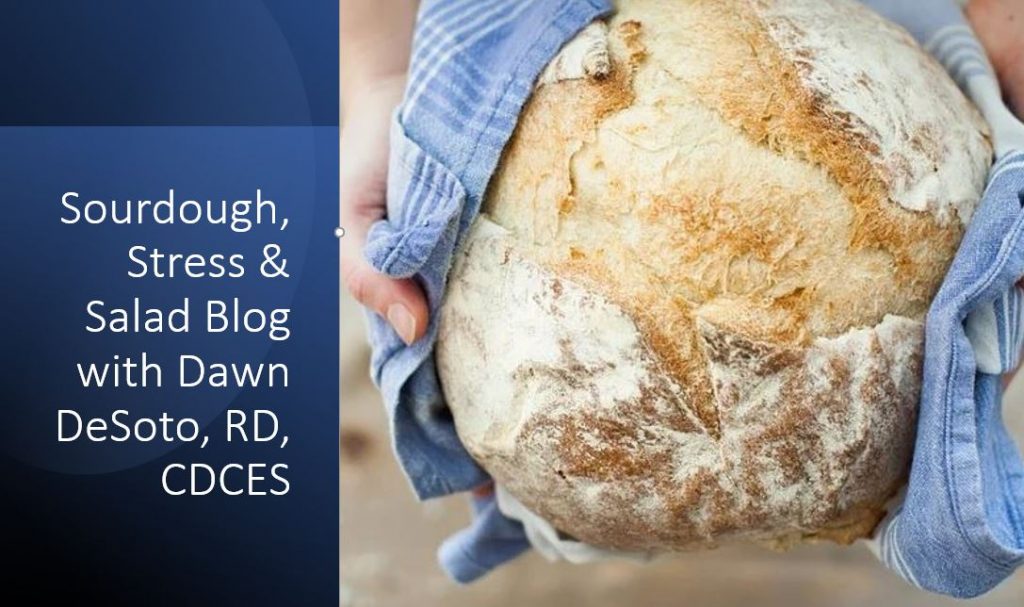Humans are hard-wired to seek comfort and relief in moments of stress.
Biologically, this is called homeostasis, which means maintaining a steady state of balance.

With the ongoing trauma of the pandemic, many of us are seeking comfort and a way to occupy our minds. Many people have adopted new hobbies to keep themselves busy, with sourdough bread baking being a popular choice. Bread products are comfort for many of us. I have not made bread as many others have, but I have been craving bread products and eating more bread, potatoes, and ice cream.
“Anything that challenges our state of balance, or any situation of lack, is deemed a stressor. This could be hunger, an uncomfortable position, feeling cold, or feeling afraid or insecure,” Dr. Eva Selhub, resiliency expert explains.
This feeling triggers an automatic reaction to leave or alleviate the uncomfortable situation, like putting on something warm if you are cold, or overeating when you are feeling insecure.
“By addressing the problem, the brain’s reward centers are stimulated along with the release of neurotransmitters like dopamine and serotonin”, continues Dr. Selhub.
At the same time, the stress hormone cortisol goes down. Solving a discomfort, then, gives us a sense of euphoria and ease. Also, carbohydrates especially lead to the increase of serotonin, the happiness hormone, which gives us the sense of feeling better.
According to Julie Ohana, a culinary art therapist, (culinary art therapy helps people communicate and manage stress through cooking), “there is a big reason people have been stress baking. When times are turned upside down we look for ways to cope”, she says. “The heart of the explanation is that cooking and baking bring comfort. The process helps aid the baker and the finished product helps comfort the person or people receiving the delicious outcome. Having control over something right now is important since so much in the world is unknown and out of our hands. When I am in the kitchen, I know what I can expect. For many, the act of baking is also calming because baking is a form of mindfulness. When we are inundated by the news and scary information, it’s important that we all take time away from the scary stuff and reset our minds and thoughts.”

Cooking sourdough bread and binge eating carbohydrates might be physiologically and psychologically comforting for some, but for our clients living with diabetes, carbohydrate cravings and binge eating can play havoc on blood sugar control, weight management, and emotional health. I had a client confide in me that when a friend brought her a warm loaf of sourdough bread she ate the whole loaf in one sitting.
TW: Mention of eating disorders below
Binge eating disorder (BED) is a severe, life-threatening, but treatable eating disorder. It is characterized by periods of uncontrolled, impulsive, or continuous eating beyond the point of comfortably full. BED is one of the newest eating disorders formally recognized in the DSM-5. Bulemia is characterized by recurrent binge eating with purging. Anorexia is centered around an obsessive fear of weight gain and involves self-starvation and often excessive weight loss. Eating disorders affect 9% of the population. 28.8 million Americans will have an eating disorder in their lifetime. Eating disorders are among the deadliest mental illness, secondary only to opioid overdose. The global economic cost of eating disorders is $64.7 billion annually. (1)
Hotline calls to the National Eating Disorders Association are up 70-80% since the beginning of the pandemic. “The risk of eating disorders is going to increase whenever there are higher levels of stress,” Lauren Smolar, Senior Director for the National Association of Eating Disorders tells us.
A survey in the International Journal of Eating Disorders in July found 62% of people in the US with anorexia experienced a worsening of symptoms as the pandemic hit. Nearly a third of Americans with binge eating disorder reported an increase in episodes. (2)
Women with T1D have nearly 2.5 times the risk of developing an eating disorder compared to those without diabetes with bulemia is the most common eating disorder in women with T1D. (3) Among women with type 2 diabetes, BED is more common. “Diabulemia” is an eating disorder characterized by intentionally withholding insulin to result in weight loss. Diabulemia is shockingly common; as many as a third of women with T1D report insulin restriction.
Compulsive overeating has compelling similarities to conventional drug addiction.
Overeating sourdough bread or other foods in the pandemic may be a red flag to us as Diabetes Care and Education Specialists to screen for possible eating disorders. In my career as a dietitian and CDCES, I have seen a lot of people who struggle with eating disorders. With compassion, we can help our clients understand the psychology of why they are binge eating.
There are a number of virtual support groups and free resources currently being offered at nationaleatingdisorder.org. On this site, there is a five-minute quiz to help determine whether our clients might need professional support.
For me, comfort foods include foods with a variety of textures, flavors, and nutrients! This recipe is a favorite of mine.
Quinoa Tabbouleh Salad Recipe

Ingredients
- 1 cup uncooked quinoa
- 1 ½ cups minced fresh flat leaf parsley
- 1 cup minced fresh mint
- 3 fresh tomatoes
- ¼ cup finely chopped scallions or onions
- ¼ cup freshly squeezed lemon juice, or more to taste
- ¼ cup extra virgin olive oil
- ¾ tsp salt, or more to taste
Instructions
- Rinse uncooked quinoa in cold water using a fine mesh strainer until the water runs clear. Drain.
- Spread quinoa in the bottom of a stain-less steel skillet in an even layer. Turn heat to medium and let the quinoa heat up, stirring occasionally, until the moisture is gone.
- Continue to cook the quinoa over medium heat, stirring frequently, for roughly 10 minutes until it begins to turn toasty and fragrant. The quinoa is ready when the seeds start to pop and turn golden brown. Remove from heat.
- Pour quinoa into saucepan along with 1 ½ cups of water. Bring to a boil, then reduce to a simmer and cover the pan.
- Cook quinoa for 10 – 12 minutes until tender, but not mushy. Stir and let cool to room temperature.
- Place minced fresh parsley and min in a medium salad bowl.
- Whisk together the lemon juice, olive oil and salt.
- Seed the tomatoes by quartering them, remove the seeds.
- Dice the tomatoes into small pieces.
- Gently stir together tomatoes, herbs, scallions, quinoa, and olive oil lemon juice dressing.
- Serve at room temperature.
This article is written by our resident nutrition expert, Dawn DeSoto, RD, CDCES
Citations
- Galmiche, M., Dechelotte, P., Lambert, G., & Tavolacci, M. P. (2019). Prevalence of eating disorders over the 2000-2018 period: a systematic literature review. American Journal of Clinical Nutrition, 109(5), 1402-1413.
- Termorshuizen JD, Watson HJ et al. Early impact of COVID-19 on individuals with self-reported eating disorders: A survey of 1000 individuals in the US and the Neverlands. International Journal of Eating Disorders. 2020;53:1
- Goebel-Fabbri A, Copeland P, Touyz S, Hay P. EDITORIAL: Eating disorders in diabetes: Discussion on issues relevant to type 1 diabetes and an overview of the Journal’s special issue. J Eat Disord. 2019;7:27

Whether you are new to diabetes or a seasoned expert, you’ll benefit from this virtual conference with the latest research plus critical content that you can immediately apply to your clinical practice.
Entire Program Fee: $399
Program Flyer: Download
Dates: Recorded & Ready for Viewing!
Live Webinar Schedule: All webinars start and end times are in Pacific Standard Time
Program Schedule & Expert Bios
What is the Diabetes Educator Course?
If you are interested in taking the CDCES or BC-ADM exam or are seeking a state of the art review of current diabetes care, this course is for you. Our team of expert faculty has been fine-tuning this course for over fifteen years, and we know what you need. In addition to informative lectures, we also use group activities and case studies to highlight the essential knowledge, skills, and strategies needed to succeed in diabetes education today!
In this course, the same speakers will cover the same content as outlined in the Live Seminar. For more details see our Virtual DiabetesEd Specialist Conference Schedule and Faculty.
Prepare for CDCES or BC-ADM certification or earn hours for renewal.
Come join our Virtual DiabetesEd Specialist Program.
Your registrations include access to all the Online Sessions plus Bonus Courses through December 31st, 2021.
This virtual program includes:
3 day live webinar courses from April 15th-17th (20 CEs) + enrollment in our Bonus Bundle (14.0+ CEs) from now through December 2021.
- Live Q & A Session with the instructor after each webinar
- Presentations by our team of experts
- Handouts and Resources for each session
- Post-test questions
- A sense of community
- If you can’t attend the live webinars, a recorded version will be posted later the same day for viewing.
View full Conference Schedule and Faculty.
Sign up for Diabetes Blog Bytes – we post one daily Blog Byte from Monday to Friday. And of course, Tuesday is our Question of the Week. It’s Informative and FREE! Sign up below!
[yikes-mailchimp form=”1″]Accreditation: Diabetes Education Services is an approved provider by the California Board of Registered Nursing, Provider 12640, and Commission on Dietetic Registration (CDR), Provider DI002. Since these programs are approved by the CDR it satisfies the CE requirements for the CDCES regardless of your profession.*
The use of DES products does not guarantee the successful passage of the CDCES exam. CBDCE does not endorse any preparatory or review materials for the CDCES exam, except for those published by CBDCE.









